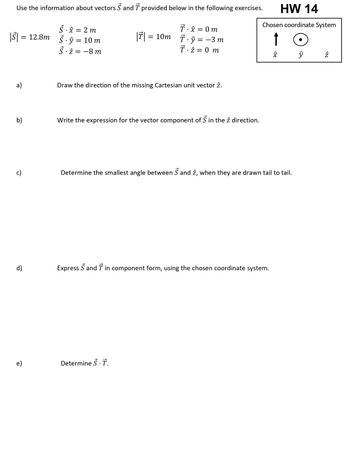Question

Transcribed Image Text:**Educational Content for HW 14 on Vectors**
**Instructions:**
Use the information about vectors \( \vec{S} \) and \( \vec{T} \) provided below in the following exercises.
---
**Vector Information:**
- \( |\vec{S}| = 12.8 \, m \)
- \( \vec{S} \cdot \hat{x} = 2 \, m \)
- \( \vec{S} \cdot \hat{y} = 10 \, m \)
- \( \vec{S} \cdot \hat{z} = -8 \, m \)
- \( |\vec{T}| = 10 \, m \)
- \( \vec{T} \cdot \hat{x} = 0 \, m \)
- \( \vec{T} \cdot \hat{y} = -3 \, m \)
- \( \vec{T} \cdot \hat{z} = 0 \, m \)
---
**Chosen Coordinate System Diagram:**
- The coordinate system shows three unit vectors:
- \( \hat{x} \) is pointing upwards.
- \( \hat{y} \) is represented by a circle with a dot in the center (indicating out of the page).
- \( \hat{z} \) is pointing to the right.
---
**Exercises:**
a) *Draw the direction of the missing Cartesian unit vector \( \hat{z} \).*
b) *Write the expression for the vector component of \( \vec{S} \) in the \( \hat{z} \) direction.*
c) *Determine the smallest angle between \( \vec{S} \) and \( \hat{z} \), when they are drawn tail to tail.*
d) *Express \( \vec{S} \) and \( \vec{T} \) in component form, using the chosen coordinate system.*
e) *Determine \( \vec{S} \cdot \vec{T} \) (the dot product).*
Expert Solution
This question has been solved!
Explore an expertly crafted, step-by-step solution for a thorough understanding of key concepts.
Step by stepSolved in 2 steps with 1 images

Knowledge Booster
Similar questions
- How to solve this problem?arrow_forwardwo vectors are defined in component form below. Use them to perform the following exercises. Note: £, §, and 2 are unit vectors of the Cartesian coordinate system defined by £ × 9 = z. S = - D Č = -152 + 82 D = -42 – 39 T = Č XD F = 5 le| = 17 Determine S. Show your ster Determine T. (Your answer should be an expression in component form.) Show your steps Determine the smallest angle between D and ý when they are drawn tail-to-tail.arrow_forwardHelp with this homework question would be great, thanks!arrow_forward
- Vector Addition Template - Problem 1 Equations for Vector Components: Polar to Rectangular Rectangular to Polar Ax = A cos e A, = A sin e R² + R,² 2 R = 0 = tan Rx = Ax + Bx + .…. Ry = Ay + By +.…. Summary of Results: Name Magnitude Angle Reference X-component Y-component Angle A 10 m 0° В 15 m 90° Resultant (R) Vector Diagrams:arrow_forwardTwo vectors are defined in component form below. Use them to answer the following questions. Note: ,ŷ, and 2 are Cartesian unit vectors. H = -5ŷ + 42 G = -5x + 22 a) Determine A if A = H.G. b) If] = G., then which of the following is true? (Choose all that are true.) Briefly explain your reasoning. i. ii. A = -J A = J c) Determine C in component form if C = H x G. d) If K = G x A, then which of the following is true? (Choose all that are true.) Briefly explain your reasoning. i. C = -K ii. iii. iv. C = R K C. K = 0 |× K = 0arrow_forwardA force F1 of magnitude of 5 N is directed in 25 degrees East of South, and a force F2 of magnitude of 2 N is directed in 30 degrees North of West. 1. Draw each vector force and give the magnitude and the direction. 2. Triangle Method of Adding Vectors a. Draw the resultant vector F3 = F1 + F2 . b. Calculate the magnitude and the direction of the resultant F3 .arrow_forward
- See attached image. Please help me solve a and b. Don't need help with c and darrow_forwardAn object is seen moving through following positions. = (0, 1) m 1 = (2, 0) m 2 = (5, – 3) m - a) Draw a picture b) Find the displacement vector for each step: Ao1 and Ař12 c) Find the total displacement: A02. (A: 5£ – 4ŷ) - d) Find the distance between the starting and ending points. (A: V41 m) e) Find the total distance travelled by the object. (A: 6.48 m)arrow_forward
arrow_back_ios
arrow_forward_ios